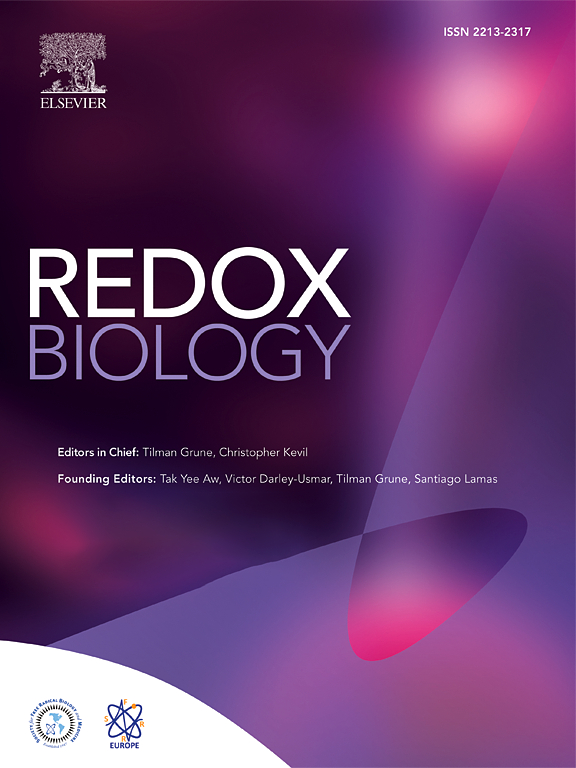PNKP targeting engages the autophagic machinery through STING and STAT3 to potentiate ferroptosis and chemotherapy in TNBC
IF 11.9
1区 生物学
Q1 BIOCHEMISTRY & MOLECULAR BIOLOGY
引用次数: 0
Abstract
The polynucleotide kinase/phosphatase (PNKP) is a DNA repair enzyme possessing bifunctional DNA 3′-phosphatase and DNA 5′-kinase activities. It plays an important role in the rejoining of single- and double-strand DNA breaks and is considered as a potential therapeutic target for different cancer types. Here we show that PNKP is highly expressed in triple negative breast cancer (TNBC) and associated with poor prognosis and chemoresistance. Targeting of PNKP enhanced ferroptosis in TNBC, which was associated with increased labile iron pool and ROS and concomitantly decreased in intracellular glutathione, SCD1 and GPX4 levels. Transcriptomic profiling and mechanistic data indicate that PNKP targeting robustly enhances the lysosomal and the autophagic machinery by activating STING and concurrently inhibiting STAT3, thereby increasing ferritinophagy, intracellular iron level and modulating the expression of key ferroptosis regulators. Importantly, PNKP and STAT3 are rapidly phosphorylated, colocalize, and interact upon ferroptosis induction or doxorubicin treatment, the first line treatment for TNBC patients. Targeting PNKP together with doxorubicin synergistically inhibited the growth of TNBC in an animal model and of TNBC-patients derived organoids. These results offer a promising therapeutic combination for TNBC and highlight the clinical potential of PNKP targeting and ferroptotic death for TNBC therapy.
PNKP靶向通过STING和STAT3参与自噬机制,增强TNBC中的铁凋亡和化疗
多核苷酸激酶/磷酸酶(PNKP)是一种具有DNA 3′-磷酸酶和DNA 5′-激酶双功能的DNA修复酶。它在单链和双链DNA断裂的重新连接中起着重要作用,被认为是不同类型癌症的潜在治疗靶点。本研究表明,PNKP在三阴性乳腺癌(TNBC)中高度表达,并与不良预后和化疗耐药相关。靶向PNKP增强TNBC中的铁凋亡,这与不稳定铁池和ROS的增加以及细胞内谷胱甘肽、SCD1和GPX4水平的降低有关。转录组学分析和机制数据表明,PNKP靶向通过激活STING并同时抑制STAT3,强有力地增强溶酶体和自噬机制,从而增加铁蛋白自噬、细胞内铁水平和调节铁凋亡关键调控因子的表达。重要的是,PNKP和STAT3在诱导铁死亡或阿霉素治疗(TNBC患者的一线治疗)时迅速磷酸化、共定位并相互作用。在动物模型和TNBC患者衍生的类器官中,靶向PNKP和阿霉素协同抑制TNBC的生长。这些结果为TNBC提供了一个有希望的治疗组合,并强调了PNKP靶向和铁致死亡在TNBC治疗中的临床潜力。
本文章由计算机程序翻译,如有差异,请以英文原文为准。
求助全文
约1分钟内获得全文
求助全文
来源期刊

Redox Biology
BIOCHEMISTRY & MOLECULAR BIOLOGY-
CiteScore
19.90
自引率
3.50%
发文量
318
审稿时长
25 days
期刊介绍:
Redox Biology is the official journal of the Society for Redox Biology and Medicine and the Society for Free Radical Research-Europe. It is also affiliated with the International Society for Free Radical Research (SFRRI). This journal serves as a platform for publishing pioneering research, innovative methods, and comprehensive review articles in the field of redox biology, encompassing both health and disease.
Redox Biology welcomes various forms of contributions, including research articles (short or full communications), methods, mini-reviews, and commentaries. Through its diverse range of published content, Redox Biology aims to foster advancements and insights in the understanding of redox biology and its implications.
 求助内容:
求助内容: 应助结果提醒方式:
应助结果提醒方式:


